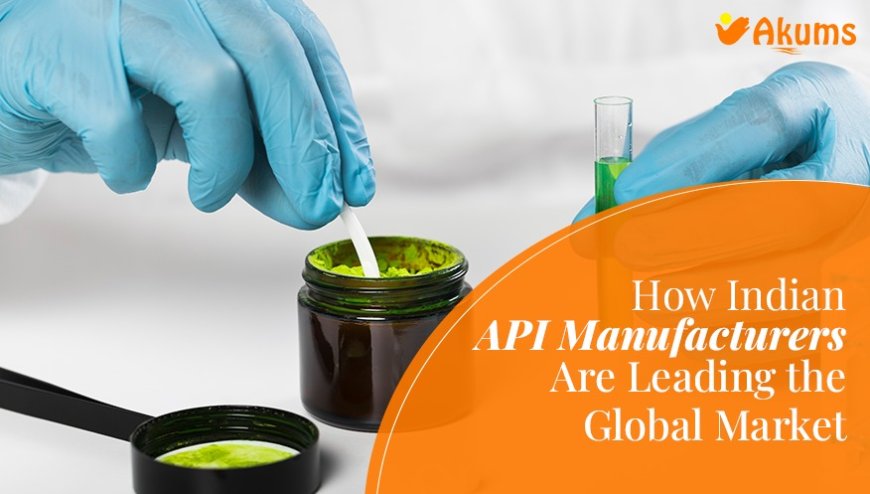How Indian API Manufacturers Are Leading the Global Market

Over the years, India has earned the title of "Pharmacy of the World" due to its unparalleled production and export of generic medications. However, recent developments show that Indias capabilities in API, the critical component to all pharmaceutical formulations, are going to a higher level. India, with its well-developed ecosystem and initiatives from the central government in the form of the Production-Linked Incentive (PLI) Scheme, is setting the foundation for API manufacturing companies in India to dominate the global pharmaceutical supply chain.
The Rise of API Manufacturing in India
Active Pharmaceutical Ingredients (APIs) are the core components that give medicines their therapeutic properties. Historically, India depended heavily on Chinese imports for APIs, sourcing nearly 70% of its requirements from across the border. This dependency was sharply highlighted during the COVID-19 pandemic, when disrupted supply chains left manufacturers scrambling. That moment acted as a wake-up call, prompting a strategic pivot toward domestic self-reliance.
The Indian API Market is expected to grow from the current estimates of about $12 billion to $22 billion by 2030, as per a report by Praxis Global Alliance. The growth is due to the quality of APIs and more importantly, the specialisation of the APIs being produced.
Government Initiatives and Policy Support
The Indian government has been a major driving force behind this transformation. In 2020, the PLI Scheme came into play which encourages the production of 54 important APIs and intermediates. By the middle of 2023, 38 of these APIs were being manufactured domestically. Furthermore, schemes like the Promotion of Bulk Drug Parks and Umbrella Scheme for Pharmaceutical Development have also enhanced infrastructure and research.
They aim to improve backward integration cut down on import dependence, and promote sustainable and eco-friendly production. This has become essential as the world moves to adopt greener options.
Strategic Shifts in Market Focus
Indian API manufacturers are gradually shifting their efforts away from mass-produced commodity APIs to higher value and specialised areas such as oncology, orphan drugs, and biosimilars. These API products, frequently used in a treatment for rare diseases, offer attractive price premiums for the manufacturer's and represent a higher profit margin than simpler APIs. These specialised APIs may also necessitate more advanced technical abilities ultimately, this is an area where Indian manufacturers are quickly developing their capabilities.
This shift is not just about tapping into new markets; its about establishing leadership in complex, high-barrier-to-entry sectors. With global demand for such specialised drugs on the rise, Indian API manufacturers are strategically positioning themselves as reliable partners for advanced pharmaceutical needs.
Strengthening the Supply Chain
Indian API companies are putting a lot of money into making intermediates and key starting materials (KSMs) to tackle supply chain problems. These steps help them cut down on outside reliance and create more reliable and affordable manufacturing processes.
Some larger players are also building Greenfield API facilities, incorporating energy-efficient processes and embracing green chemistry principles. These eco-conscious investments are not only regulatory compliant but also future-proof, as global buyers increasingly favour sustainable sourcing.
Quality, Compliance, and Innovation
Compliance is becoming a sharper differentiator with a more stringent regime by the US FDA, EMA and WHO. Indian API companies that have digital quality management systems (QMS), and have implemented automation and Quality by Design (QbD) methods, are differentiating themselves in a competitive marketplace. The implementation of data integrity tools and digital document control systems provide common credibility and transparency, both important factors in a global collaborative environment.
India is also experiencing growth in virtual API firms that use digital platforms to handle sourcing, logistics, and regulatory tasks. This approach eliminates the demand for large-scale investments and gives more room to adapt, making it a transformative option to help smaller and quicker manufacturers thrive.
Cosmetics and Beyond
While pharmaceuticals will always be the mainstay of the sector, Indias API ecosystem is diversifying into adjacent areas, such as personal care and cosmetics. Due to growing global demands for quality and safe ingredients, India is increasingly qualifying as a manufacturer of cosmetics raw materials. There is also a natural extension between the pharmaceutical-grade manufacturing developed in India and the production of cosmetics, making India a natural fit for these new verticals.
Conclusion
India's rise as a global leader in API manufacturing is not by accident but has been facilitated by a combination of established government policies, infrastructure investment, a skilled workforce, and keen attention to quality and sustainability. Whether its oncology or orphan drugs, the players of API manufacturing in India are pushing global benchmarks with respect to innovation, compliance and resilience. As the market matures, India is not only participating in the global API equity story; it is writing a new chapter.




































